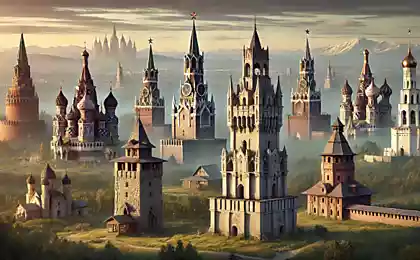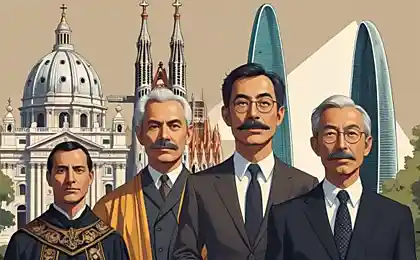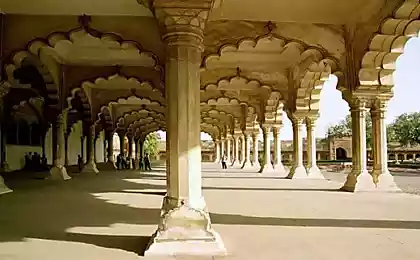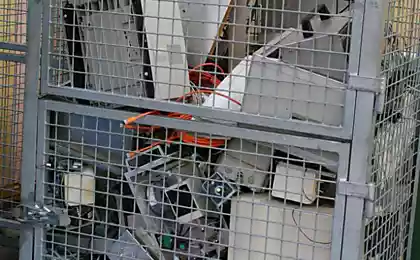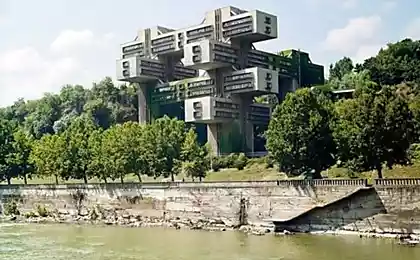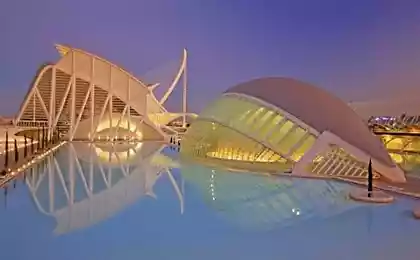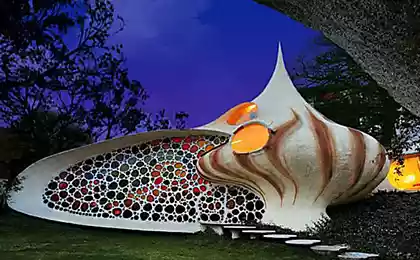2060
A masterpiece of industrial architecture (43 pics + text)
Can a utilitarian enterprise to be beautiful? A plant for waste disposal?
Throughout his life, Austrian architect Hundertwasser break stereotypes. And he left behind not only a wonderful home,
but cheerful, totally unconventional industries. As this incinerator Maishima in Osaka.
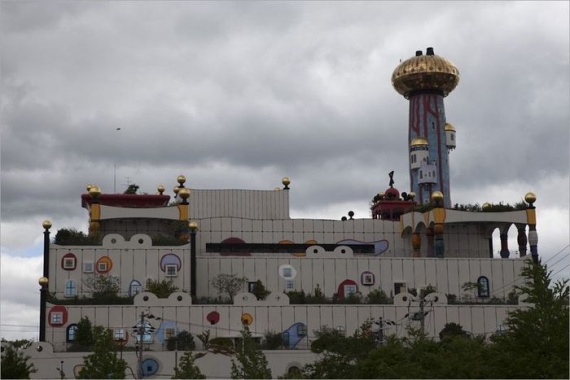
From a distance, amid gray parallelepipeds enterprises industrial zone, primitive fence of the bridge, the plant seems to be a stranger, an amusement park, accidentally caught in the zone functionality.

Across the street - another plant. On it burn sewage sludge. Toy huge child forgotten in the industrial zone.
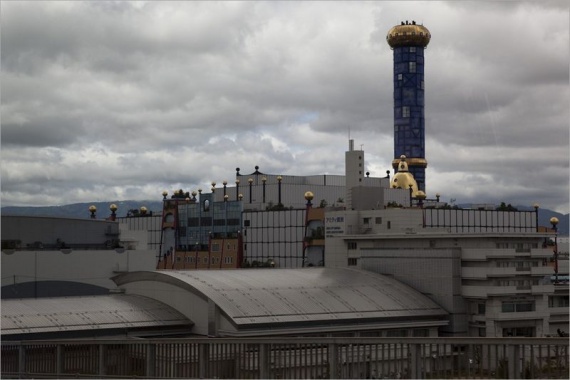
You never thought about what happens to waste water sewerage? They fall to the treatment plant, where the purified water is returned to the industrial use. It remains yl or "sludge". We dispose of the sediment in vast areas of the maps that cheap, but ... released into the atmosphere gases from rotting, and besides, the "product" contains a bouquet of hazardous substances, including heavy metals. In industrialized countries, has long passed for incineration of sludge. The energy released in the process is used for the issuance of heat and electricity to the city network. Powerful multi-stage gas cleaning system suppresses harmful emissions. Note the absence of smoke over the blue pipe with decorative gilded domes. A plant running at full capacity! Emissions of course there is - but mostly carbon dioxide and water vapor. In terms of emissions of burning hundreds of times "cleaner" than the dumping of the sediment at the site, no matter how amazing it sounds. A picture on the cover - a plant for incineration of household waste, ordinary waste, also functioning at full capacity. And the same benefits as before disposal at the landfill. Such plants around the world - in 2500! And build new ones. Some are decorated with nice architectural solutions. And there are isolated instances of which can be attributed to the masterpieces of industrial architecture.
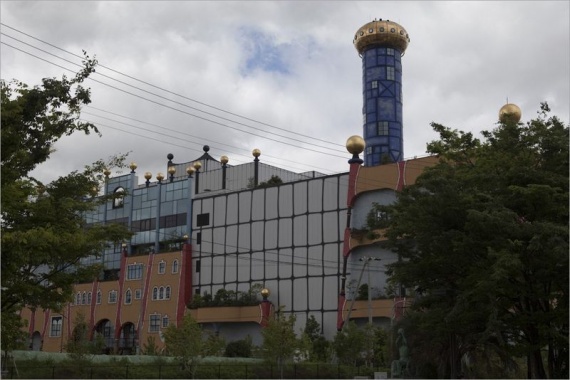
Two plants form a single complex, also perform social functions. There is a rehabilitation center for the disabled.
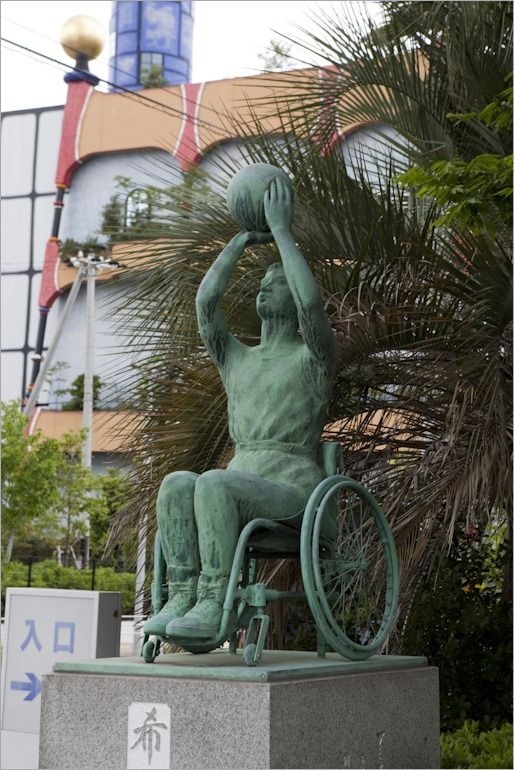
And the hotel for families and disabled travelers just individuals. The restaurant food is very good. But the Japanese style.
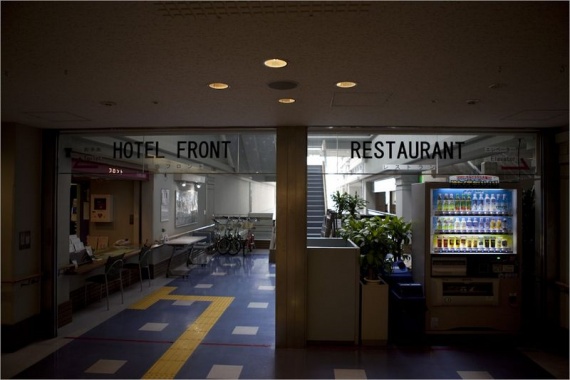
View restaurant on the bridges of Osaka. To the right, behind a tree, you can see the Ferris wheel - cyclopean structure. Types of Osaka from the height of engineering genius - another time.
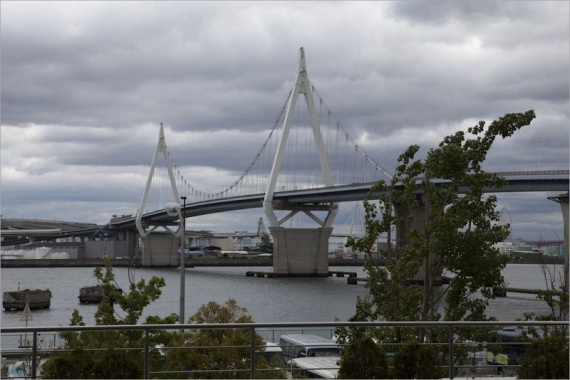
And yet - the incinerator. Photos of this building on the web quite a lot. But they are made only from the outside. And inside is no less interesting, I assure you! A sign at the entrance indicates that the plant was launched in 2000. It was built for the 2008 Olympics, as well as many other facilities in the city. But Beijing's winning bid. Well it is, by the way. And yet - among other things - the plant started 8 years before the planned Games. No associations? Hundertwasser did not live six months before the start of the enterprise. However, all the plans were embodied the genius of the artist.
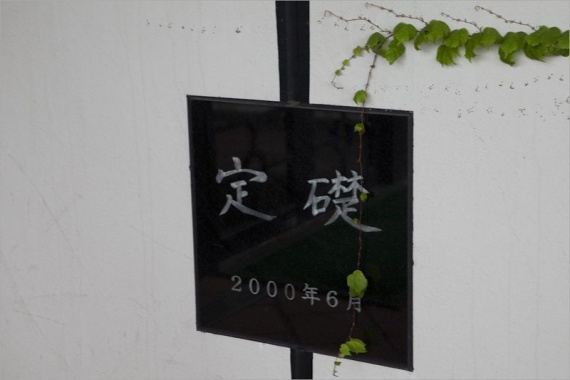
Column canopy at the entrance. Glazed ceramic tile - the main element of the decor of the building. Drainpipe could be easily hidden, but the master, apparently, felt it necessary to emphasize the connection with nature. Come inside!
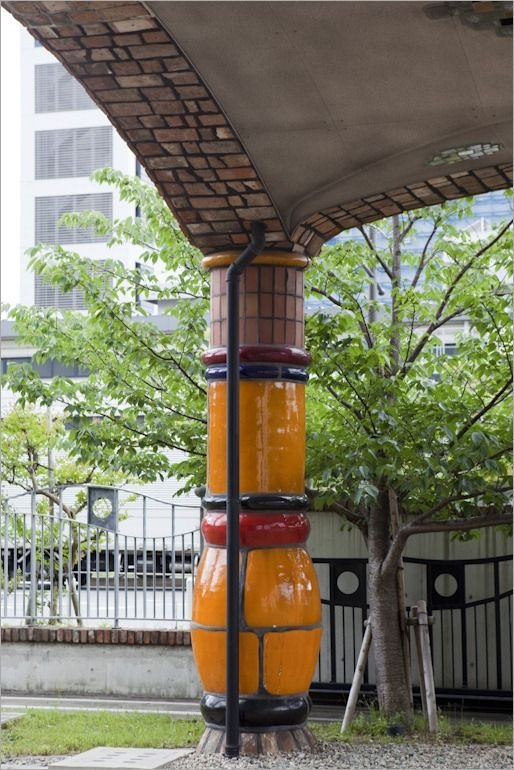
Hundertwasser fought mercilessly with smooth surfaces wherever possible. It is not just homes corridors - by their twists like the walls of the cave.

From the windows more visible plant for incineration of sludge.

And pipes incinerator. Like a tree, it grows out of the ground.
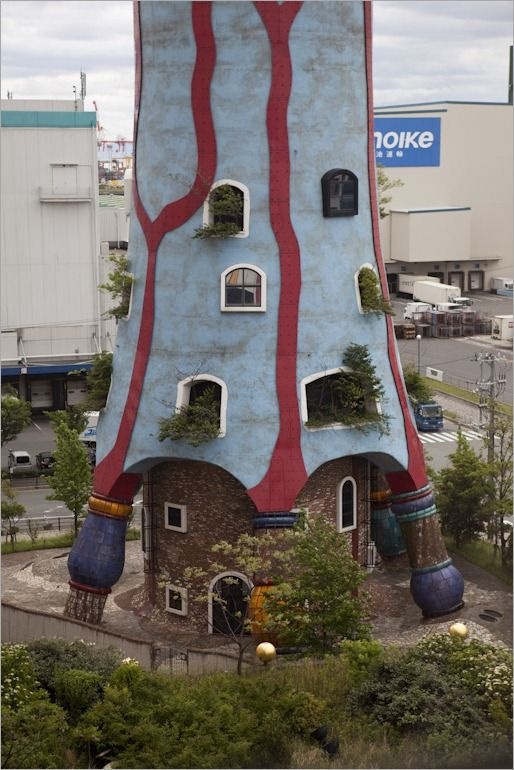
Pinnacle and gilded poppyhead not have any functionality.
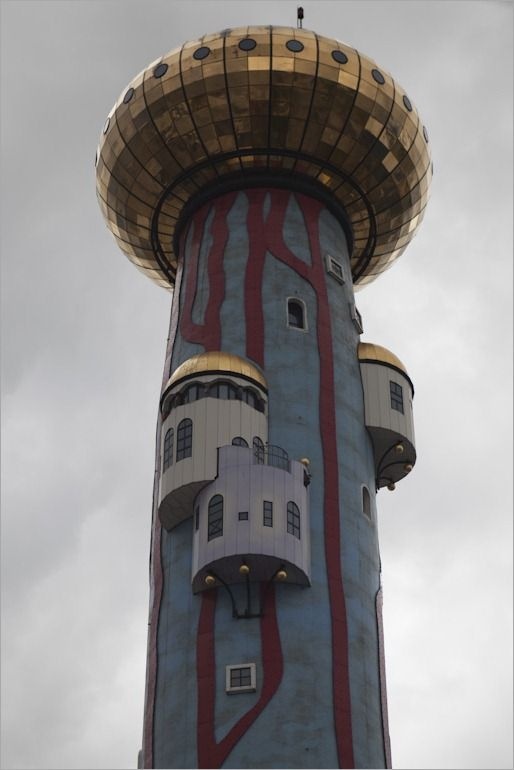
Go ahead - the interiors of all entertaining.

Near a small conference room is a small exhibition. The layout of the plant, the first sketches of the master, photos of construction.

This layout of the incinerator in Vienna, district Shpittelau. Wikipedia is a company wrongly called the boiler room. The company also burn household waste, due to give heat and electricity for the city. The plant operates almost in the center of Vienna, and his pipe is a cafe with a beautiful view.
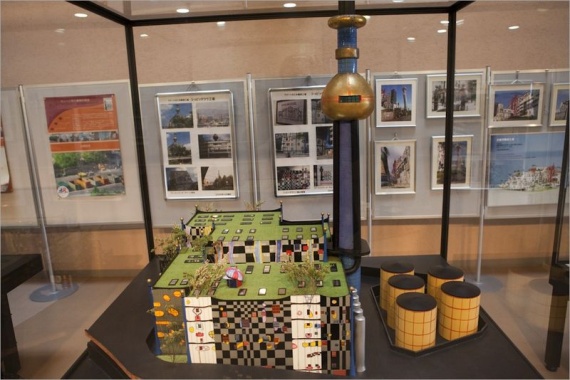
The layout of the plant in Osaka in the section. Those who are not interested in technology, I advise to skip the next paragraph. Left blue garbage handling calls in the office. Open the gates and the car throws debris into the hopper. Two grab crane orange produce loading debris into a funnel furnaces. The plant two identical incineration lines arranged in parallel to each other. Visible only one, of course. From the crater, marked by dark red dust through the gateway enters the oven, on the grill. Grid - central element of the whole system, but per se does not look like. Rather, it is a giant staircase 30 meters long, 20 wide and 10 high. Steps are moving relative to each other, providing peretalkivanie garbage for complete and uniform combustion. Bottom through the thinnest cracks fed combustion air. Design and manufacture of such a mechanism, working in extreme temperature conditions, are capable of individual firms in the world. On the layout grid, located obliquely, painted red. Above it - a large rectangular combustion chamber of the furnace, painted in shades of gray. There's gases are maintained for 2 seconds at a temperature of 850 degrees for the decomposition of dioxins, which we are so fond of scaring "green." Through numerous heat exchanger pipes gases enter the chimney brown. Heated in a heat exchanger (boiler) pairs of silver tube is sent to the green cube of the turbine, which drives a generator in the blue box. Electricity is spent on personal needs of the plant and into the net. A brown fumes enter the flue gas cleaning system multi. Olive-colored cylinder - a scrubber where the injected lime milk and activated carbon to suppress harmful compounds. To the right of his three green "inverted house" - a bag filter where in the maze of cloth sleeves deposited dust and the smallest impurities. Because over the pipe and clean.
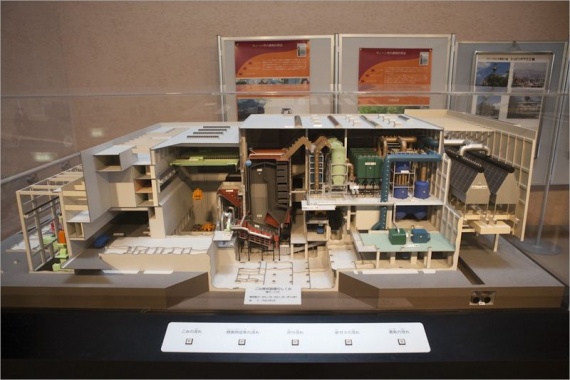
In the conference room of the plant are stored paintings Hundertwasser associated with the plant, sketches, models.
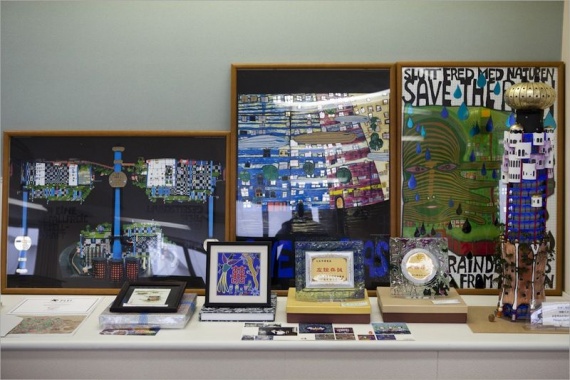
The original layout of the factory pipe. He was rejected by the city in view of the particular complexity and high cost performance.
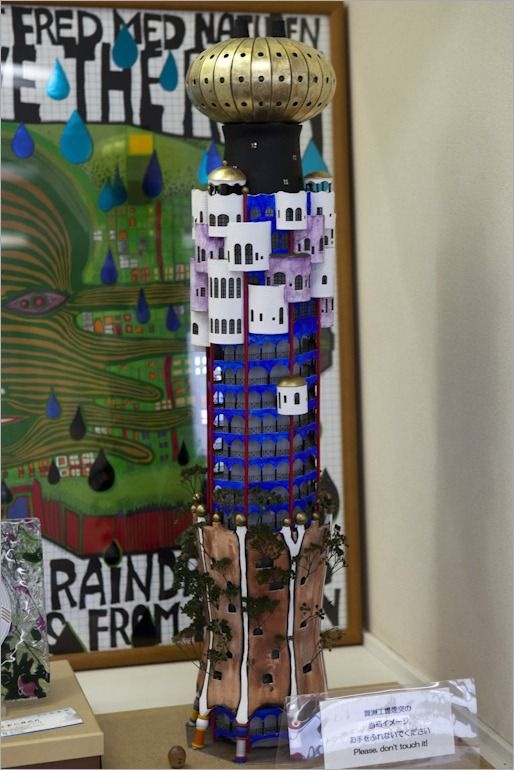
This is the final version.

The first working sketch of the architectural solution of the plant, made a master's hand.
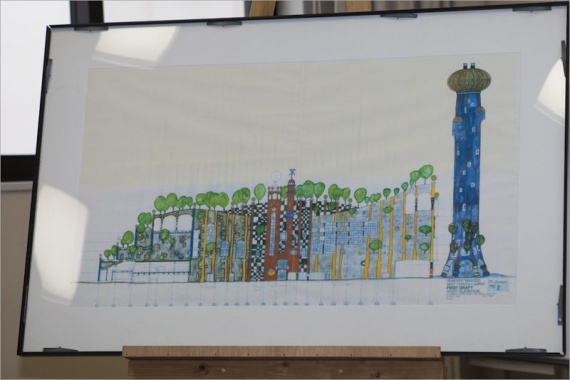
But enough of pictures and sketches! We turn to photography. Without embellishment, and Photoshop. The receiving department. Garbage trucks drove up to the automatic doors and dumped debris into the hopper. To prevent the spread of odor in the department maintained a slightly reduced pressure. The air from the ventilation system enters the furnace for incineration.
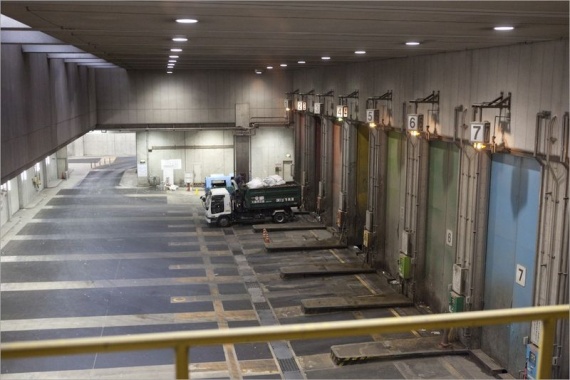
This header bin waste. On the day the plant burns 900 tons of household waste, ie about 300,000 tons per year. Hopper has to provide stock for the plant for 3 days. Thus, it can accommodate up to 2,700 tons of household waste. It's almost 50 wagons of debris. Who debris deep down, the plant operates practically "with wheels."

Two grab crane for loading debris into the hopper furnaces.
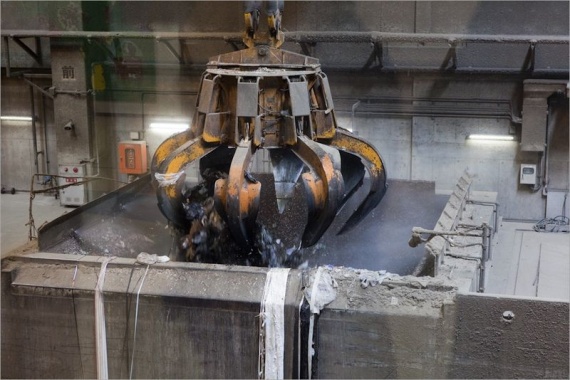
The crane operator sits in an isolated room of the bunker. By controlling the crane, it provides a uniform sample of the hopper and the mixing of garbage. After selecting the point of capture hand he presses a button and the automatic control of the crane makes loading debris into a funnel on their own. Javascript is necessary to mix the valve to maintain uniform moisture and preventing spontaneous combustion in the bunker. In theory, such a possibility exists, because in the bunker installed diagnostics and automatic fire.
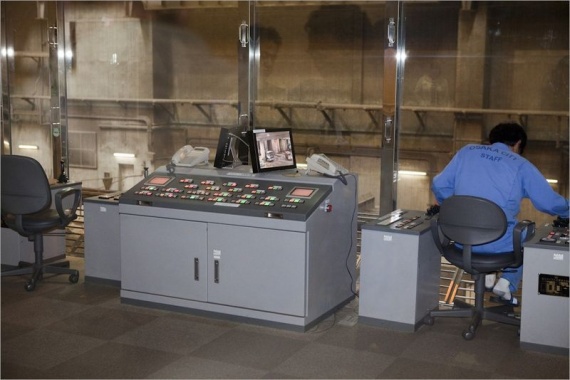
The premises of the plant, where the furnace, boiler and gas cleaning, was not allowed - the puncture of the organizers. Past the intricacies of pipes and assemblies, we were directed to the panoramic window of the generator room.

Here, under the green casing is a turbine. The steam is fed to the right on a silver trumpet. The turbine drives a generator in a blue box. Produce energy, again, enough for the needs of the plant and delivery of electricity to the network.
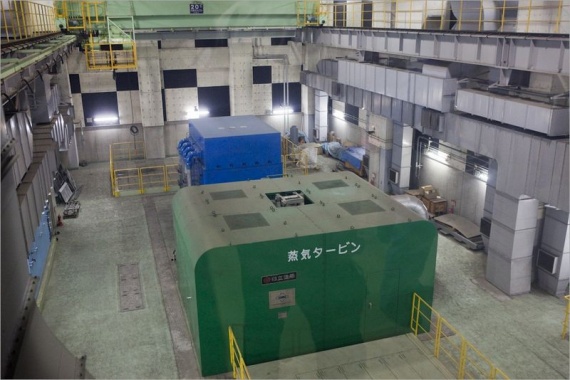
Demonstration boards and mechanisms for children. Indications of energy production, however, the real - more than 9 MW. Domestic consumption of the plant - about 3 megawatts. Thus, 6 MW currently issued to the network. At an average rate of consumption, it is enough to heat 175 thousand square meters of residential apartments. And even offer kids and twist handle these small generators on the floor to feel what 100 watts of power, enough for "firing" one bulb.

To twist - and light up here are "electric colors."
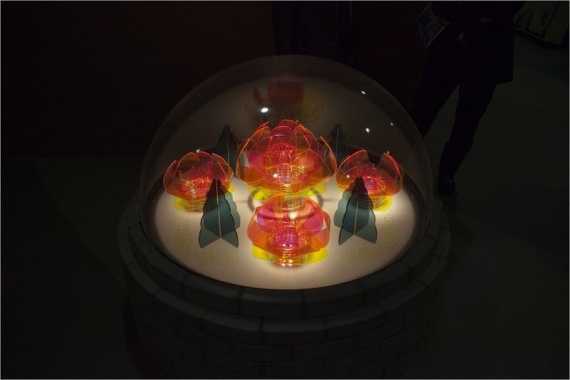
But more interesting, in my opinion, photos turbine during installation. Hundreds blades take steam at a pressure of 40 atm and a temperature of about 250 degrees.
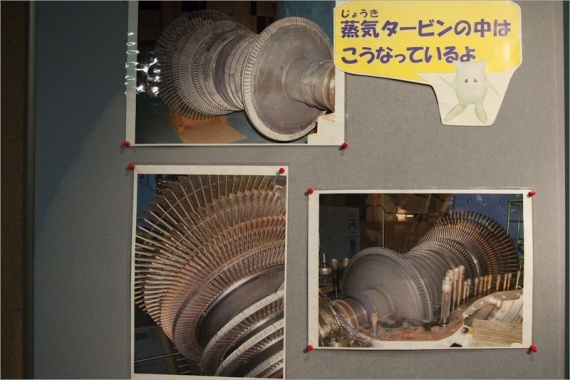
Strange kind of corridors we were taken to the central control plant.
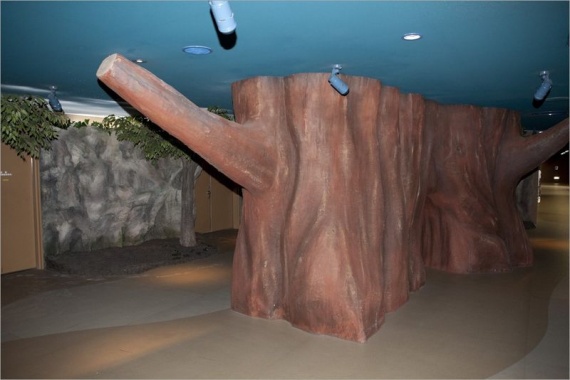
The "Rock" set monitors with informative information to students.

The main control panel is designed to "unload" operators. Blue "sky" with the clouds overhead, bio-design stands. Flow charts with information from the automated control system of the plant displayed on the computer screen. Weak. Who decided to make "video cubes" on the control boards, with the display circuitry on large screens. But the computer display is performed to cope with the work. They have data on temperature, air supply, the level of emissions. The combustion parameters are changed automatically depending on the sensors to the pipe factory.
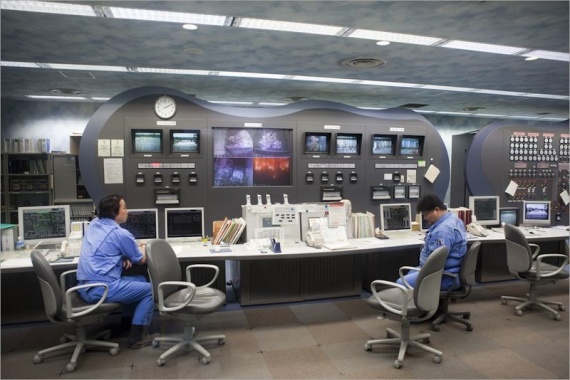
On the quad screen in the center of the stand - video hoppers and from the oven.
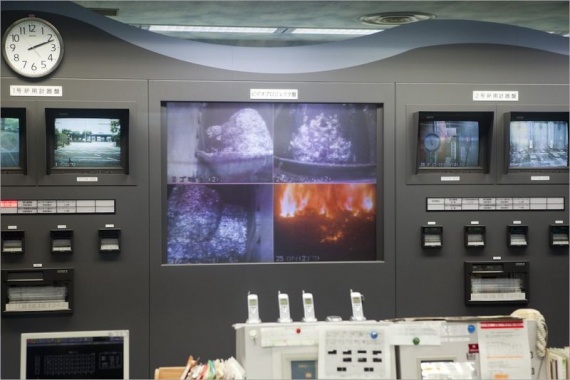
Stand control and power unit at all technically too old. Rubilnichki, buttons, dial indicators. It is at the level of 70-ies. But it works.
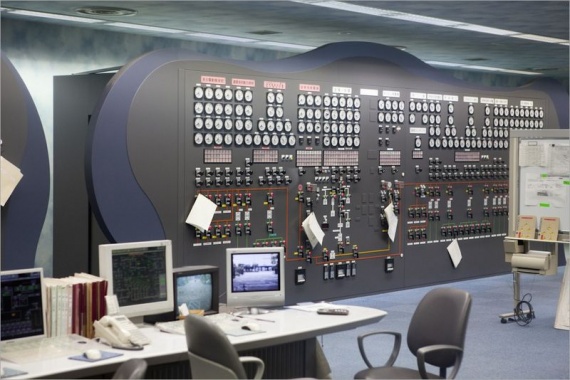
Not only here. The output - Stand with photos incinerators Osaka. In a city with 8 million population - 9 incinerators. And no one is on strike, it does not go to the demonstration. The air in the order of two Osaka purer than in Moscow. By the way, all photos - existing enterprises. Where crimson smoke from the chimney, which drew our rustic "green" demonstrations along Tverskaya? Where people in masks?
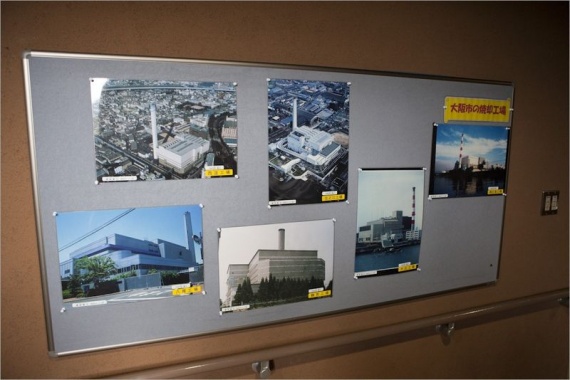
Fit to wear masks in Moscow. Because 95% of emissions in our capital caused by transport. Killed, dirty shack, chadyaschie "KAMAZ". And plants are not operating. But to deal with road relaxed out troublesome and politically unpromising. Big names currently do not do this. And in Osaka, and the whole country, are not engaged in demagoguery. There are building factories. Including graceful architecture as in the lower picture.
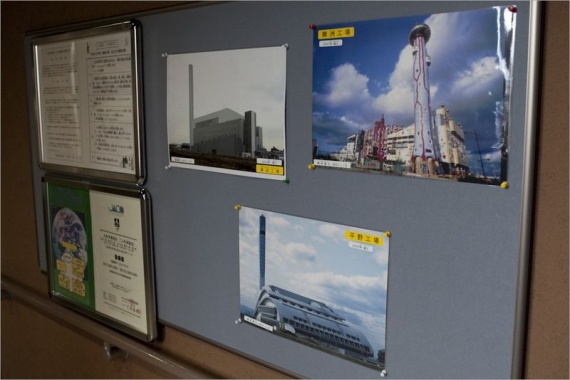
Anyway, we leave. The view from the window on the entry of the plant group. Radiation monitoring (radioactive waste require a completely different recycling procedures), weight, dispatch. Green stripes on the asphalt - weighing cells. The car weighs in at the entrance and at the exit, the difference - adopted the trash.
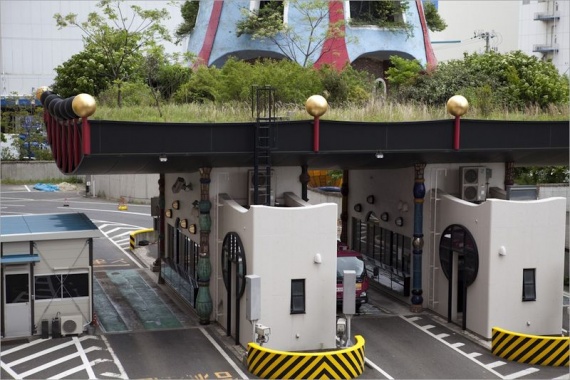
Documents checked garbage enters the territory.
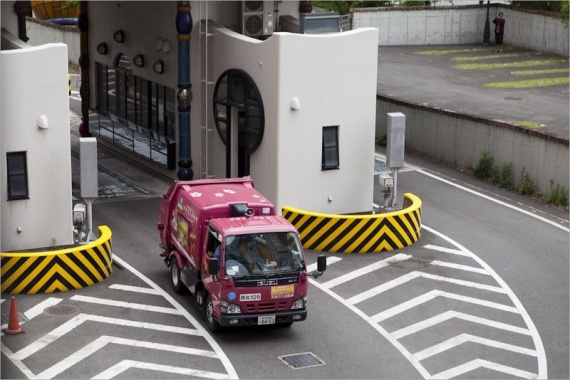
Again, the beauty-pipe. Strange blue tree. Cameron borrowed from Hundertwasser?

Kind hosts. Smiling, polite, but not for the Grand Prix does not exceed the number of dispensing information. However, it seems, did not know more than what they said. They tried to answer, consulted among themselves, but without much result. Probably still do not have the level of experts. For high school students. Well, as they say, and thanks for that. The plant shown in general everything is clear.
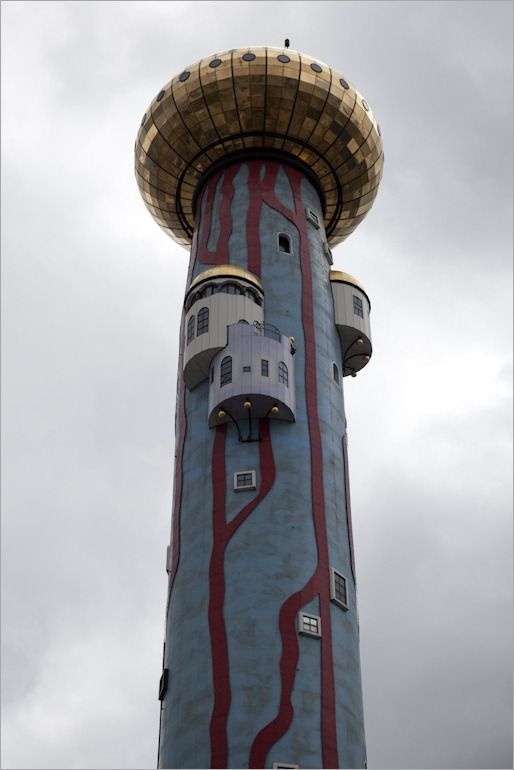
Important in this plant, of course, not the technology. The main thing - the joy of life, which gives great Austrian solar architecture.
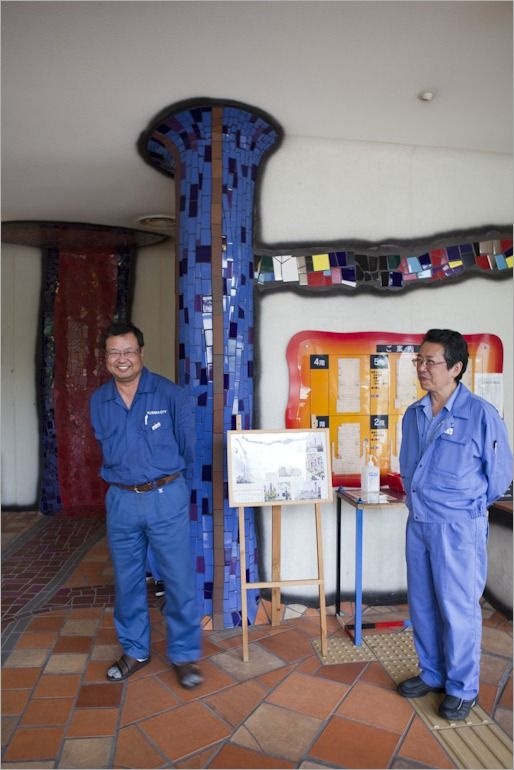
And I assure you, for the cost of the plant, these architectural excesses - a small gain. It is a pity that so few industrial facilities are being built with the assistance of prominent architects. At these plants, and work easier, and our city, they can decorate, like pearls.
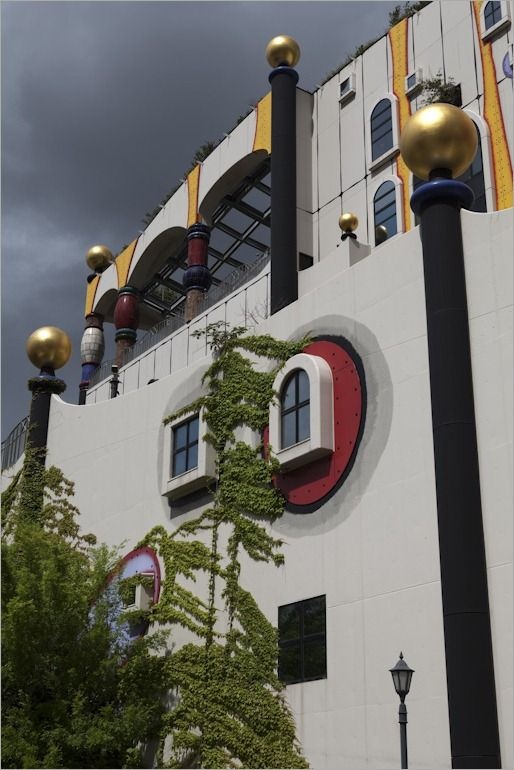
via igergel Source:
Throughout his life, Austrian architect Hundertwasser break stereotypes. And he left behind not only a wonderful home,
but cheerful, totally unconventional industries. As this incinerator Maishima in Osaka.

From a distance, amid gray parallelepipeds enterprises industrial zone, primitive fence of the bridge, the plant seems to be a stranger, an amusement park, accidentally caught in the zone functionality.

Across the street - another plant. On it burn sewage sludge. Toy huge child forgotten in the industrial zone.

You never thought about what happens to waste water sewerage? They fall to the treatment plant, where the purified water is returned to the industrial use. It remains yl or "sludge". We dispose of the sediment in vast areas of the maps that cheap, but ... released into the atmosphere gases from rotting, and besides, the "product" contains a bouquet of hazardous substances, including heavy metals. In industrialized countries, has long passed for incineration of sludge. The energy released in the process is used for the issuance of heat and electricity to the city network. Powerful multi-stage gas cleaning system suppresses harmful emissions. Note the absence of smoke over the blue pipe with decorative gilded domes. A plant running at full capacity! Emissions of course there is - but mostly carbon dioxide and water vapor. In terms of emissions of burning hundreds of times "cleaner" than the dumping of the sediment at the site, no matter how amazing it sounds. A picture on the cover - a plant for incineration of household waste, ordinary waste, also functioning at full capacity. And the same benefits as before disposal at the landfill. Such plants around the world - in 2500! And build new ones. Some are decorated with nice architectural solutions. And there are isolated instances of which can be attributed to the masterpieces of industrial architecture.

Two plants form a single complex, also perform social functions. There is a rehabilitation center for the disabled.

And the hotel for families and disabled travelers just individuals. The restaurant food is very good. But the Japanese style.

View restaurant on the bridges of Osaka. To the right, behind a tree, you can see the Ferris wheel - cyclopean structure. Types of Osaka from the height of engineering genius - another time.

And yet - the incinerator. Photos of this building on the web quite a lot. But they are made only from the outside. And inside is no less interesting, I assure you! A sign at the entrance indicates that the plant was launched in 2000. It was built for the 2008 Olympics, as well as many other facilities in the city. But Beijing's winning bid. Well it is, by the way. And yet - among other things - the plant started 8 years before the planned Games. No associations? Hundertwasser did not live six months before the start of the enterprise. However, all the plans were embodied the genius of the artist.

Column canopy at the entrance. Glazed ceramic tile - the main element of the decor of the building. Drainpipe could be easily hidden, but the master, apparently, felt it necessary to emphasize the connection with nature. Come inside!

Hundertwasser fought mercilessly with smooth surfaces wherever possible. It is not just homes corridors - by their twists like the walls of the cave.

From the windows more visible plant for incineration of sludge.

And pipes incinerator. Like a tree, it grows out of the ground.

Pinnacle and gilded poppyhead not have any functionality.

Go ahead - the interiors of all entertaining.

Near a small conference room is a small exhibition. The layout of the plant, the first sketches of the master, photos of construction.

This layout of the incinerator in Vienna, district Shpittelau. Wikipedia is a company wrongly called the boiler room. The company also burn household waste, due to give heat and electricity for the city. The plant operates almost in the center of Vienna, and his pipe is a cafe with a beautiful view.

The layout of the plant in Osaka in the section. Those who are not interested in technology, I advise to skip the next paragraph. Left blue garbage handling calls in the office. Open the gates and the car throws debris into the hopper. Two grab crane orange produce loading debris into a funnel furnaces. The plant two identical incineration lines arranged in parallel to each other. Visible only one, of course. From the crater, marked by dark red dust through the gateway enters the oven, on the grill. Grid - central element of the whole system, but per se does not look like. Rather, it is a giant staircase 30 meters long, 20 wide and 10 high. Steps are moving relative to each other, providing peretalkivanie garbage for complete and uniform combustion. Bottom through the thinnest cracks fed combustion air. Design and manufacture of such a mechanism, working in extreme temperature conditions, are capable of individual firms in the world. On the layout grid, located obliquely, painted red. Above it - a large rectangular combustion chamber of the furnace, painted in shades of gray. There's gases are maintained for 2 seconds at a temperature of 850 degrees for the decomposition of dioxins, which we are so fond of scaring "green." Through numerous heat exchanger pipes gases enter the chimney brown. Heated in a heat exchanger (boiler) pairs of silver tube is sent to the green cube of the turbine, which drives a generator in the blue box. Electricity is spent on personal needs of the plant and into the net. A brown fumes enter the flue gas cleaning system multi. Olive-colored cylinder - a scrubber where the injected lime milk and activated carbon to suppress harmful compounds. To the right of his three green "inverted house" - a bag filter where in the maze of cloth sleeves deposited dust and the smallest impurities. Because over the pipe and clean.

In the conference room of the plant are stored paintings Hundertwasser associated with the plant, sketches, models.

The original layout of the factory pipe. He was rejected by the city in view of the particular complexity and high cost performance.

This is the final version.

The first working sketch of the architectural solution of the plant, made a master's hand.

But enough of pictures and sketches! We turn to photography. Without embellishment, and Photoshop. The receiving department. Garbage trucks drove up to the automatic doors and dumped debris into the hopper. To prevent the spread of odor in the department maintained a slightly reduced pressure. The air from the ventilation system enters the furnace for incineration.

This header bin waste. On the day the plant burns 900 tons of household waste, ie about 300,000 tons per year. Hopper has to provide stock for the plant for 3 days. Thus, it can accommodate up to 2,700 tons of household waste. It's almost 50 wagons of debris. Who debris deep down, the plant operates practically "with wheels."

Two grab crane for loading debris into the hopper furnaces.

The crane operator sits in an isolated room of the bunker. By controlling the crane, it provides a uniform sample of the hopper and the mixing of garbage. After selecting the point of capture hand he presses a button and the automatic control of the crane makes loading debris into a funnel on their own. Javascript is necessary to mix the valve to maintain uniform moisture and preventing spontaneous combustion in the bunker. In theory, such a possibility exists, because in the bunker installed diagnostics and automatic fire.

The premises of the plant, where the furnace, boiler and gas cleaning, was not allowed - the puncture of the organizers. Past the intricacies of pipes and assemblies, we were directed to the panoramic window of the generator room.

Here, under the green casing is a turbine. The steam is fed to the right on a silver trumpet. The turbine drives a generator in a blue box. Produce energy, again, enough for the needs of the plant and delivery of electricity to the network.

Demonstration boards and mechanisms for children. Indications of energy production, however, the real - more than 9 MW. Domestic consumption of the plant - about 3 megawatts. Thus, 6 MW currently issued to the network. At an average rate of consumption, it is enough to heat 175 thousand square meters of residential apartments. And even offer kids and twist handle these small generators on the floor to feel what 100 watts of power, enough for "firing" one bulb.

To twist - and light up here are "electric colors."

But more interesting, in my opinion, photos turbine during installation. Hundreds blades take steam at a pressure of 40 atm and a temperature of about 250 degrees.

Strange kind of corridors we were taken to the central control plant.

The "Rock" set monitors with informative information to students.

The main control panel is designed to "unload" operators. Blue "sky" with the clouds overhead, bio-design stands. Flow charts with information from the automated control system of the plant displayed on the computer screen. Weak. Who decided to make "video cubes" on the control boards, with the display circuitry on large screens. But the computer display is performed to cope with the work. They have data on temperature, air supply, the level of emissions. The combustion parameters are changed automatically depending on the sensors to the pipe factory.

On the quad screen in the center of the stand - video hoppers and from the oven.

Stand control and power unit at all technically too old. Rubilnichki, buttons, dial indicators. It is at the level of 70-ies. But it works.

Not only here. The output - Stand with photos incinerators Osaka. In a city with 8 million population - 9 incinerators. And no one is on strike, it does not go to the demonstration. The air in the order of two Osaka purer than in Moscow. By the way, all photos - existing enterprises. Where crimson smoke from the chimney, which drew our rustic "green" demonstrations along Tverskaya? Where people in masks?

Fit to wear masks in Moscow. Because 95% of emissions in our capital caused by transport. Killed, dirty shack, chadyaschie "KAMAZ". And plants are not operating. But to deal with road relaxed out troublesome and politically unpromising. Big names currently do not do this. And in Osaka, and the whole country, are not engaged in demagoguery. There are building factories. Including graceful architecture as in the lower picture.

Anyway, we leave. The view from the window on the entry of the plant group. Radiation monitoring (radioactive waste require a completely different recycling procedures), weight, dispatch. Green stripes on the asphalt - weighing cells. The car weighs in at the entrance and at the exit, the difference - adopted the trash.

Documents checked garbage enters the territory.

Again, the beauty-pipe. Strange blue tree. Cameron borrowed from Hundertwasser?

Kind hosts. Smiling, polite, but not for the Grand Prix does not exceed the number of dispensing information. However, it seems, did not know more than what they said. They tried to answer, consulted among themselves, but without much result. Probably still do not have the level of experts. For high school students. Well, as they say, and thanks for that. The plant shown in general everything is clear.

Important in this plant, of course, not the technology. The main thing - the joy of life, which gives great Austrian solar architecture.

And I assure you, for the cost of the plant, these architectural excesses - a small gain. It is a pity that so few industrial facilities are being built with the assistance of prominent architects. At these plants, and work easier, and our city, they can decorate, like pearls.

via igergel Source:
Washington - city officials and patriotism (43 photos)
The last 30 years of the USSR through the lens of the camera (90 photos)





